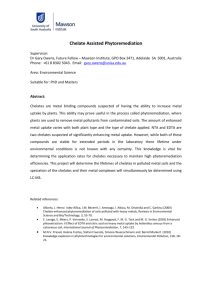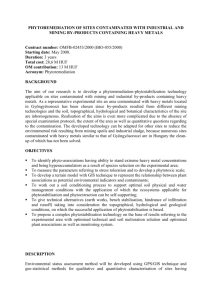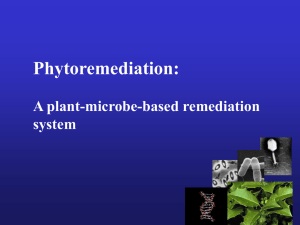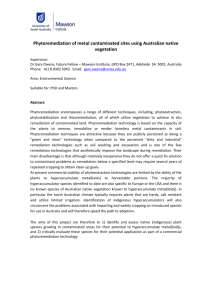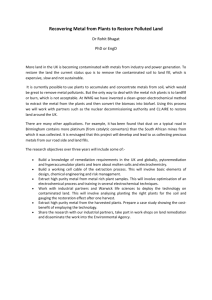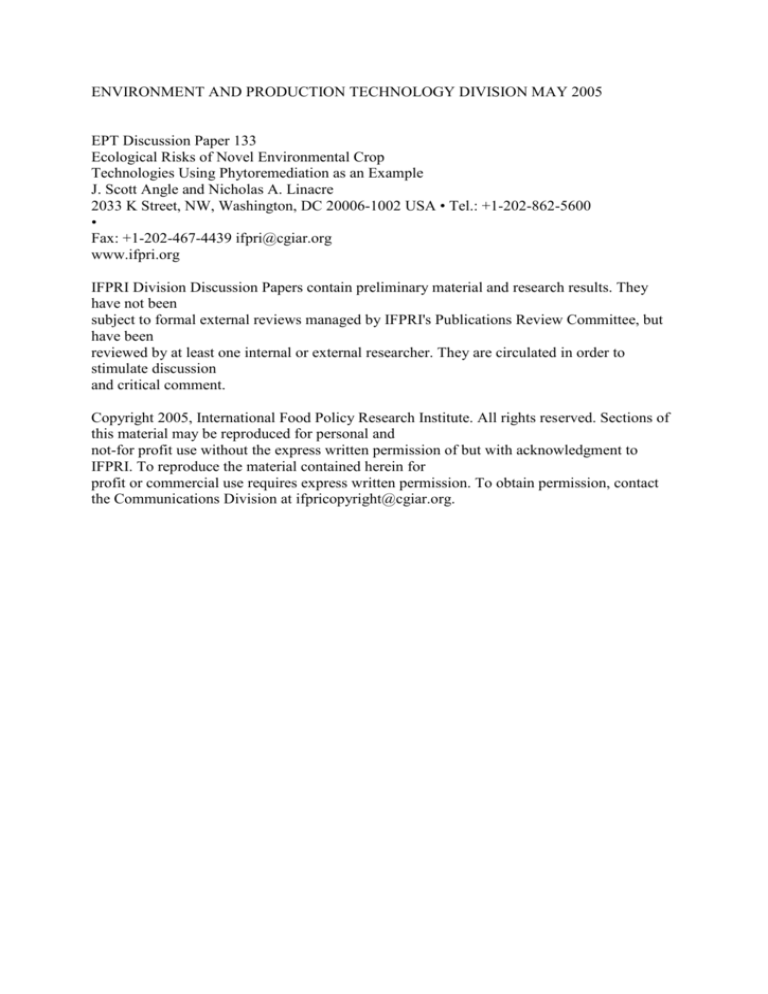
ENVIRONMENT AND PRODUCTION TECHNOLOGY DIVISION MAY 2005
EPT Discussion Paper 133
Ecological Risks of Novel Environmental Crop
Technologies Using Phytoremediation as an Example
J. Scott Angle and Nicholas A. Linacre
2033 K Street, NW, Washington, DC 20006-1002 USA • Tel.: +1-202-862-5600
•
Fax: +1-202-467-4439 ifpri@cgiar.org
www.ifpri.org
IFPRI Division Discussion Papers contain preliminary material and research results. They
have not been
subject to formal external reviews managed by IFPRI's Publications Review Committee, but
have been
reviewed by at least one internal or external researcher. They are circulated in order to
stimulate discussion
and critical comment.
Copyright 2005, International Food Policy Research Institute. All rights reserved. Sections of
this material may be reproduced for personal and
not-for profit use without the express written permission of but with acknowledgment to
IFPRI. To reproduce the material contained herein for
profit or commercial use requires express written permission. To obtain permission, contact
the Communications Division at ifpricopyright@cgiar.org.
ABSTRACT
Phytoremediation is the use of living plants, known as hyperaccumulators which absorb
unusually large amounts of metals in comparison to other plants. The use of classical
plant breeding and new molecular techniques offers great potential to develop crops with
the ability to clean up polluted sites. While these technologies have gained widespread
attention, prior to commercial development, there are risks that must be considered – only
a few of which have received even modest examination. Therefore, the focus of this
working paper is to explore specific risks associated with phytoremediation and suggest
ways in which these risks can be managed so that new, novel, and innovative plant
technologies may be applied to provide low cost and efficient environmental solutions.
Keywords: risk, GMO, biotechnology, phytoremediation, phytoextraction, phytomining
i
TABLE OF CONTENTS
1. Introduction 1
2. Pre-plant considerations 3
3. Naturally Occurring Hyperaccumulators 5
3. Ecotoxicity 6
4. ‘Weediness’ 9
5. Gene flow and introgression 11
6. Cultivation on contaminated areas 13
7. Cultivation on naturally enriched areas 14
8. Volunteers 15
9. GMO hyperaccumulators 16
10. Biomass disposal 19
11. Conclusions 21
References 22
ii
Ecological Risks of Novel Environmental Crop Technologies Using
Phytoremediation as an Example
J. Scott Angle1 and Nicholas A. Linacre2
1. INTRODUCTION
Phytoremediation is the use of living plants, known as hyperaccumulators which
absorb unusually large amounts of metals in comparison to other plants3, for in situ
remediation of contaminated soil, sludges, sediments, and groundwater through
contaminant removal, degradation, or containment (Baker et al. 1994; Chaney,1983a;
Glass 1999). While these technologies have gained widespread attention, prior to
commercial development, there are risks that must be considered – only a few of which
have received even modest examination. Therefore, the focus of this working paper is to
explore specific risks associated with phytoremediation.
Phytoremediation offers the possibility of addressing an intractable global
problem by providing an alternative, cheap and effective technology that could
significantly improve the prospects of cleaning-up metal contaminated sites (Garbisu and
Alkorta 2001; Salt et al. 1995). The advantages of phytoremediation over traditional
methods of remediation are well known. The many benefits of the technology have been
reviewed by Wolfe and Bjornstad (2002). However, few attempts to assess the specific
risks of the technology have been reported.
Theoretical aspects of the risk analysis process were recently reviewed by Linacre
et al. (2003). The primary conclusion of this paper was that risks must be identified,
1 College of Agriculture and Natural Resources, 1201 Symons Hall, University of Maryland,
College Park,
MD 20742, USA2 International Food Policy Research Institute, 2033 K Street NW,
Washington, DC 20006
3 http://www.epa.gov/tio/download/remed/phytoresgude.pdf
2
quantified, managed and communicated if phytoremediation is going to find broad public
acceptance. Indeed, as a corollary, some of the current concerns related to use of
genetically modified agricultural commodities arise from past lack of appreciation for
risk assessment, management and communication (MacKenzie 1994). Acceptance of
genetically modified organisms (GMOs), at least in the US, has been directly attributed to
the eventual public understanding of risks and benefits.
Risk may be defined as the likelihood of occurrence of a negative consequence
(Kaplan and Garrick 1981). In the context of phytoremediation, risks are primarily the
result of exposure of living organisms to metals. Risk, therefore, depends on the
likelihood of exposure, the level of exposure and on the toxic effects of exposure. It is the
combination of these factors that dictates the risk which can vary from negligible to high
when the likelihood, level and consequences of exposure are significant. Using a
sourcepathwayreceptor model to identify possible risks, the failure to clean up contaminated
sites (source) could lead to risk or harm to plants, animals, humans and natural resources
such as water (receptors) via significant pollutant linkages (pathways).
Risks in phytoremediation can arise from a number of potential sources. Some
risks relate to the direct exposure to metals, while other risks relate to the preparation,
cultivation and disposal of materials. This review is divided into a number of sections and
discusses: (1) preplanting risks created by soil preparation, (2) risks associated with the
transfer of planting materials, (3) potential ecotoxicity, (4) potential weediness, (5) gene
flow and introgression, (6) and (7) cultivation risks, (8) volunteers, (9) “additional” risks
associated with GMO phtyoremediators, and (10) biomass disposal.
3
2. PRE-PLANT CONSIDERATIONS
Prior to planting of hyperaccumulators, soils are often prepared by adding
materials to reduce soil pH. Numerous studies have shown that most hyperaccumulators
take up more metal at low pH due to enhanced solubility (Marschner 1995). pH
reduction is therefore considered a critical component to most phytoremediation
technologies. The only exception to this rule was reported by Li et al. (2003) and Kukier
et al. (2004) who showed that maximum uptake of Ni by Alyssum murale was at pH
greater than 7.5.
However, low pH in the presence of high metal content can exasperate
ecotoxicity. Numerous studies have shown that metals can be toxic to most
nonhyperaccumulator
plants (and even some hyperaccumulators) when soil pH is reduced to
6.0 and below (Chaney 1983b). Further, many soil bacteria and other organisms are
sensitive to high metal concentrations which are also affected by lowering pH of high
metal soils.
This risk is currently a focus of an on going program in our laboratory. We
examined the extent of damage done to an ecosystem when soil pH was reduced for a
high metal soil, and whether this damage was permanent or if the ecosystem could be
restored to normal by subsequent increase in the soil pH at the end of phytoremediation.
Results demonstrated that both microbial number and function are highly sensitive to the
toxic effects of soil metals at low soil pH. When soil pH was returned to more
appropriate agronomic levels, most parameters, but not all, returned to normal within a
six month period.
4
Reducing pH of low metal soil can also enhance metal solubility to the point
where leaching is a concern. Angle et al. (unpublished data) has shown that when soil pH
is reduced to values less than 6.4 for Cd and 4.7 for Zn enriched soils, loss from soil via
leaching is a significant concern. Metal contaminated groundwater is one of the most
difficult media to remediate and should be avoided at all possible costs.
Another soil management option that has been examined is to add organic
chelators to soil to increase solubility and thus metal uptake (Blaylock et al. 1997; Lombi
et al. 2001). Both aminopolycarboxylic acids (Shen et al. 2002; Huang et al. 1997) and
organic acids (Huang et al. 1998; Ebbs et al. 1998) have been studied for their ability to
increase metal uptake into plants. While occasionally effective (Meers et al. 2004), these
materials have significant limitations that until now have restricted their utility. For both
materials, enhanced leaching of chelate-bound metals into groundwater as a result of
increased solubility is an important concern (Cunningham et al. 1997; Kedziorek and
Bourg 2002). Greman et al. (2001) showed that EDTA added to soil increased leaching
losses of metals by up to 40%. One of the paramount rules of remediation is to avoid
contaminant dispersal. While it might be possible to balance chelate addition to soil so
that only metal taken up by the plant is available at any point in time, the temporal
considerations related to full season phytoremediation suggest this to be quite difficult.
A further potential concern is the cost of adding amendments to soil. Sulfur
added to lower soil pH is relatively cost effective and thus insignificant to the overall cost
of phytoremediation. However, chelates can be quite expensive. Chaney et al. (2004)
has reported that the cost of adding 10 mmol EDTA kg-1 soil is about $30,000 per ha.
5
3. NATURALLY OCCURRING HYPERACCUMULATORS
Hyperaccumulators are either direct seeded into contaminated or mineralized soils
or plantlets are transplanted into the soil. In either case, seed or soils associated with
transplants can carry soil bacteria, fungi and viruses that are not indigenous to the area
being phytoextracted, potentially posing risks to soil microflora and indigenous plants.
However, risk management approaches exist such as soil sterilization and growing
plantlets in locally collected soils. One consequence of this approach that is difficult to
mitigate the impacts of deliberately introduced soil bacteria important for
phytoremediation.
Abou-Shanab et al. (2003) showed that the rhizosphere of Alyssum murale, the
most important Ni hyperaccumulator studied to date, has bacteria within its rhizosphere
that can increase Ni solubility and thus Ni uptake into the plant. While the presence of Ni
solubilizing bacteria in soil is beneficial in that phytoremediation efficiency is increased,
if these bacteria were also to increase uptake into non hyperaccumulator plants, results
could be harmful to the food chain. Abou-Shanab et al. (2003) reported that specific
bacteria when inoculated into soil increase Ni uptake by up to 33%. Other studies have
shown that the rhizosphere of hyperaccumulators increases metal uptake into plants,
although specific reasons for this observation were not considered (Schwartz et al. 2003;
Whiting et al. 2001).
6
3. ECOTOXICITY
During phytoremediation, hyperaccumulators are direct seeded or transplanted into metal
enriched soil. Early in the process, plant biomass content is low, and ecotoxicity is
seldom a concern. However, soon after germination or planting, metal content in
biomass increases to levels that can potentially be toxic to the ecosystem. Several studies
have shown that hyperaccumulators fail to grow well when foliar concentrations of select
metals are low (Li et al. 2004). Li et al reported that Thlaspi caerulescens needs 1000x
more Zn to grow ‘normally’ when compared to non-hyperaccumulators. For example, T.
caerulescens can concentrate up to 40,000 ug g-1 Zn (Brown et al. 1994, 1995) while A.
murale can accumulate similar amounts in above ground biomass (Chaney et al. 2000).
Although the exact reason for metal hyperaccumulation has yet to be fully understood,
many scientists believe this phenotype evolved as a way of induced foliar toxicity and
thus reduce feeding by a variety of insects (Boyd and Martens 1994).
Several studies have examined impacts of high metal biomass on insects. This
information has been extensively reviewed by Boyd and Martens (1992 1998). Boyd et
al. (1998) examined direct toxic effects on high metal biomass on both feeding preference
and toxicity on insects. It was shown that most insect species prefer low metal biomass
when given a choice in feeding studies. Less direct effects on reproductive success are
more poorly understood. Effects related to behavior may be important but have not yet
been examined to our knowledge.
Interestingly, some insects seem to have developed methods for avoiding metal
exposure. Aphids for example, due to rapid pass through of fluids, are able to excrete
much of the metal consumed during feeding from the phloem. Further, phloem sap
7
generally has lower metal content compared to materials flowing up into the shoot given
that this is an important part of the hyperaccumulation process.
We are not aware of any studies that have directly examined toxicity to higher
animals consuming high metal hyperaccumulator biomass. However, it is quite
reasonable to assume that that exposure to and consumption of high metal biomass could
be toxic to wildlife. During large-scale phytoremediation, it will be nearly impossible to
fence out all herbivores. We are also aware of concerns related to farm animals getting
into fields of hyperaccumulators. Fencing, screens and netting are generally ineffective
in preventing movement of all animals into a field in phytoremediation.
Fortunately, most hyperaccumulators are relatively unpalatable probably due to
the high alkaloid and metal content found in hyperaccumulators. Thus, while it might be
possible that animals will graze on hyperaccumlators, the likelihood of significant
consumption is minimal. Our observations of large fields planted to hyperaccumulators
are that few, if any, large herbivores forage in these fields. Only when few other foods
are present can animals be expected to ingest significant quantities of hyperaccumulator
biomass.
Despite the relative unpalatibility of high metal hyperaccumulators, it is always
possible that insects could develop resistance to metals, and thus increase feeding and
exposure. This has been observed recently for Bt crops as well as for a host of more
traditional insecticides.
Further, while most large herbivores have a large grazing range and can simply
move to other locations, small herbivores and territorial animals may not have this
opportunity. Voles, shrews etc have very limited foraging range and may simply not
8
have the ability to move beyond the confines of a field planted contiguously to
hyperaccumulators. Given quantities of roots, stems and leaves consumed and the
average metal content of hyperaccumulators, it is readily conceivable that these animals
could ingest potentially lethal amounts of metal.
There are no current standards for maximum ingestion of metals by wildlife, but
such data are available for livestock. Table 1 (Madejon, et al. 2002) shows the maximum
levels of metals tolerated by common livestock species. Hyperaccumulator
concentrations for all metals far exceed levels considered toxic to cattle, sheep, swine and
chickens, often by orders of magnitude.
Table 1--Metal concentrations for ‘typical’ agronomic plants, phytotoxic metal
concentrations in plants, metal concentrations used for delineation of
hyperaccumulators and maximum metal concentrations tolerated by
livestock.
Metal Plant avg. Phytotoxicity Hyperacc Max. conc. tolerated by animals
-----------------mg kg-1-------------------- ----------mg kg-1 in diet---------Cattle Sheep Chicken
Cd 0.1 – 1 5 – 700 >1,000 0.5 0.5 0.5
Cu 3 – 20 25 – 40 >10,000 100 25 300
Mn 15 – 150 400 – 2,000 >10,000 1,000 400 2,000
Ni 0.1 – 5 50 – 100 >10,000 50 100 300
Zn 15 – 150 500 – 1,500 >10,000 300 1,000 1,000
Adapted from Madejon et al. 2002
Acknowledging that some herbivores with limited foraging range may be killed or
injured by the consumption of hyperaccumulators, this hazard must be assessed in terms
of risks of doing nothing or the risks of more traditional methods of dig and haul. Doing
nothing is often not an option while dig and haul, with replacement of the contaminated
soil – and resident small herbivores, will almost certainly be fatal to all wildlife of limited
foraging range. Loss of some small herbivores might well be a ‘cost’ of return of the soil
ecosystem to a healthy state.
If hyperaccumulator consumption by wildlife is a concern, there are wellestablished
methods to reduce wildlife ingestion of hyperaccumulators. Fencing,
deterrents such as periodic noise, and planting of offensive plant species can all be used
to reduce contact between wildlife and hyperaccumulators. While not fully effective,
these methods will at least reduce exposure.
4. ‘WEEDINESS’
Most hyperaccumulators evolved under extreme conditions thus they tend to be
quite hardy. Many of these plants evolved on soils that were highly infertile with little
water holding capacity. The climate under which many hyperaccumulators evolved is
often extreme with cool moist winters and hot and dry summers (Brooks 1998). Our
experience has been that hyperaccumulators are quite hardy and survive with little care.
Indeed, this is one of the characteristics that make these plants amendable to cultivation.
By definition, most hyperaccumulators are ‘weeds’, in that they: 1) reproduce
rapidly, 2) grow under conditions of low fertility, and 3) are adapted to a wide range of
environmental (soil and climate) conditions. Consequently one of the most immediate
concerns related to phytoremediation is the potential escape of hyperaccumulators from
the site of remediation and the possibility that these plants will become environmental
weeds.
Numerous examples documenting the ‘escape’ of plants moved from one location
to another have been reported. Kudzu, autumn olive, multiflora rose, and Japanese
10
honeysuckle were all intentionally imported into the US, often for agricultural or
ornamental purposes. Currently the US spends over $15B annually to control weeds.
Most weeds were originally imported into the US either intentionally or accidentally.
Most hyperaccumulators will not be used commercially where they evolved, thus import
into other areas will be necessary. However, importing a non-indigenous species into
many countries can be a problem. Therefore the first choice when selecting a plant
species for use is to select an indigenous hyperaccumulator.
A more general notion of a weed is that of “a plant growing in a place where it is
not wanted.” In this sense evidence exists that the physiological limitations of
hyperaccumulator plants may limit their potential for weediness. Many
hyperaccumulators have been reported to survive only on metal enriched soils. It has
been suggested that high shoot metal content, and subsequent toxicity to pathogens and
insects is one of the primary reasons why metals are accumulated (Pollard et al. 2002).
When hyperaccumulators were grown in low metal soil, we have observed that plants
rapidly die from fungal disease. Most often, we have identified Pythium or Phythopera
root disease as the causative agent of death and decline.
It is suggested that hyperaccumulators have abandoned other methods of
protection from disease for genetic efficiency. Thus, when metals are low, uptake is
reduced and the plants are left ‘defenseless’. For this reason, it is unlikely that
hyperaccumulators that escape from the site of cultivation would survive to become a
permanent component of the ecosystem. Plants would most likely die as a result of being
left without the high metal defense. We, therefore, do not believe that control using
11
herbicides will be necessary to protect against escape outside areas of metal
contamination or artificial enrichment.
Even if movement of seed is restricted beyond the original area of establishment,
pollen from hyperaccumulators can travel with wind and insects for many kilometers.
Numerous crop species have been shown to hybridize with wild relatives, including
sunflower, radish, canola and millet. Traits that increase gene flow and outcrossing
include self-incompatibility, high outcrossing rates and biotic pollination. Thlaspi is
generally considered to be self-pollinating but cross-pollination ranges from 5 to 25%.
This concern will be discussed in more detail in the next section.
5. GENE FLOW AND INTROGRESSION
Pollen dispersal may be critical because it affects the likely breadth of dispersal of
genetic material containing metal accumulating genes. It has been reported that the
primary method by which genes may move from a GMO crop to a weedy relative is
through pollen movement (Kareiva et al. 1994). It might be possible that genes coding
for metal uptake and sequestration could be transferred to other crop or non crop plants.
For crop plants, transfer of high metal uptake is a very serious concern. Incorporation of
metal uptake genes into crops plants could lead to food and feed that exceed national and
international standards for metal concentration. In addition to food quality concerns,
export markets can be negatively affected by high metal content.
The primary method for flow of genes from both GMO and non-GMO crops to
related relatives is through the process of introgression. Introgression is defined as the
natural spread of genes of one species into another through the process of interspecific
12
hybridization followed by successive backcrosses to the parent. This process results in
offspring that have similar genotypes to the wild type but incorporate new genes from the
domesticated, exotic or GM plants.
Most plant species outcross to some extent with other plants. Although T.
caerulescens was originally thought to have only limited outcrossing, i.e. approximately
5% (Riley 1956) more recent evidence has suggested that outcrossing for this species
might be much higher. Koch (1998) demonstrated that outcrossing rates in T.
caerulescens could reach as high as 88%. It has also been suggested that higher
outcrossing may occur on contaminated soils compared to plants grown on less polluted
soil (Dubois et al. 2003).
Just about every cultivated crop has shown hybridization with at least one wild
relative (Arias and Rieseberg 1994; National Research Council 1989). Sexually
compatible weeds or indigenous species almost always occur within the growing area of
most known cultivated plant species. For this reason, outcrossing during
phytoremediation should be anticipated and controlled to the extent possible.
There are many factors that can affect the flow of pollen and genes from one plant
to another – some of which can potentially be managed and reduced. The most important
factors affecting gene flow include the degree of out-crossing and the potential for biotic
pollen movement. In general, high out-crossing rates and biotic pollination, such as with
bees, will increase the rate of gene flow between plant species. Pollen can be dispersed
by a variety of vectors: wind, insects, mammals and birds. The role different vectors play
in long versus short distance dispersal is species specific. And, in the case of GM crops,
the type of gene may affect the rate of introgression. Glover (2002) cites the example of
13
insect protected cotton where there has been a 37-54 percent reduction in insecticide use.
This in turn may increase local insect populations, increasing the abundance of pollen
vectors therefore increasing the rate of introgression.
6. CULTIVATION ON CONTAMINATED AREAS
For many soil metal contaminants, especially Zn and Ni, within a metal
contaminated area, hyperaccumulator plants are likely to do well since foliar
concentrations will be high. This may result in the plants spreading within the
contaminated area and displacing other “indigenous” species. However, diversity on
contaminated sites is typically low with the more aggressive species being dominant and
many species previously growing on contaminated sites are themselves considered
weeds. Therefore since this is an area needing remediation, spreading within the
contaminated area and displacement of other “indigenous” species is generally
considered a positive attribute.
On the other hand, for metals such as Cd in contaminated or mineralized soils,
soil concentrations never or rarely approach levels that are toxic to plants. Cadmium
tends to have few effects on plant growth, yet can still exhibit toxicity to animals. While
this does not obviate the ecotoxicity of high Cd plants, Cd hyperaccumulators will not be
able to grow beyond the area of soil contamination. Thus, escape of Cd
hyperaccumulators beyond the area of contamination is not likely to be a concern. These
observations suggest that escape from the original site must be assessed based upon both
the plant and soil.
14
7. CULTIVATION ON NATURALLY ENRICHED AREAS
Cultivation of hyperaccumulators on naturally enriched areas offers the greatest
promise for use in phytomining. Phytomining is a more specific form of
phytoremediation where the purpose of metal removal from soil is economic gain. For
example, millions of acres of Ni rich ultramafic soil are found around the world. These
soils are potentially amendable to Ni phytomining. However, many of these areas are
populated by a number of rare and endangered species. For example, serpentine soils in
northern California and southern Oregon are populated by rare and endemic species that
exist only on these soils (Kruckeberg 1954;1984). Given the unique flora of enriched
soils, concern has been raised that highly competitive and aggressive introduced
hyperaccumulators may displace some of the natural flora. The literature is replete with
examples of introduced plant species dominating fragile ecosystems. We have
experience working on a serpentine pine barren. Pines were never part of the indigenous
ecosystem, and only came to dominate as part of human activity (clear cutting). This has
threatened much of the indigenous flora in serpentine areas and has led to debate as to
whether pines should be removed by logging.
As discussed, concerns related to escape of introduced hyperaccumulators exist
and must be addressed prior to project initiation. It is therefore critical to establishment a
protocol to monitor the potential for escape from the original area of introduction. Where
escape in found, survival should be observed to determine whether this is temporary or
whether escaped hyperaccumulators have the potential to become established as a
permanent component of the ecosystem.
15
Angle et al. (2001) has reported that many hyperaccumulators are readily
controlled with herbicides. Therefore, where escape is found, it is possible to control
these individuals with herbicides. However, this is both an expensive and time
consuming process and there can be no guarantee that all escaped plants will be found
and killed.
Another method to reduce the potential for escape from the original site of
planting is to harvest plants prior to seed set. Most hyperaccumulators set seed in mid
summer. Since most hyperaccumulators are perennials, they will typically be harvested
at the time of maximum metal accumulation, then plants will continue to grow for an
additional harvest the same year or in the following year. Fortunately, maximum metal
accumulation usually occurs just about at the time of flowering. It is therefore possible to
harvest plants before seed are produced. Alternatively, for locations where it is unlikely
that plants will survive the entire year (i.e. growing temperate hyperaccumulators in
tropical areas), plants can be grown as annuals and again harvested before seed set.
8. VOLUNTEERS
After remediation is complete there remains the limited potential for some seed,
stored in the soil seed bank, to germinate, which may pose a small risk. However, this
risk may be managed using on site volunteer management. Different approaches are
available and will depend on the crop. Generally, rotation with another crop, against
which any phytoremediation volunteers will be visually obvious, allows the volunteers to
be identified and removed. The potential for volunteers can also be reduced by
16
harvesting before seed set, which reduces the likelihood of seed entering the soil seed
bank.
9. GMO HYPERACCUMULATORS
Genetic studies related to hyperaccumulators have been underway for many years
Karenlämpi et al. 2000; Whiting et al. 2004). Most studies have focused on the
identification of genes involved in the process of hyperaccumulation – uptake, transport
and sequestration (Rutherford, et al. 2004; Wang et al. 2002). However, a few studies
have resulted in the development of GMO hyperaccumulators, hopefully with enhanced
potential to extract metals from soil. Dhankher et al. (2002) reported the development of
a plant with enhanced tolerance and uptake of arsenic. More recently, several studies
have described transgenic plants with the ability to take up and volatize selenium (Van
Huysen et al. 2003; 2004). Brassica juncea was engineered to over express a key
enzyme in the sulfur assimilation pathway, which resulted in significantly greater uptake
of Se. Probably the greatest amount of study, and resulting publicity has occurred for
poplar trees engineered for Hg uptake. Bizily et al. (2001, 2003) and Pilon-Smits and
Pilon (2000) studied the insertion of genes that could potentially enhance Hg uptake and
volatilization. This work has successfully resulted in the production of transgenic trees
that increase Hg uptake and volatilization from soil. Similar reports that transgenic plants
can increase Se uptake and volatilization have also recently been reported (Pilon-Smits et
al. 1999a, 1999b).
While the genomics of phytoremediation is proceeding at a rapid pace, concerns
have been raised regarding this approach. Imagine the public reaction to the following
GMO hyperaccumulator:
17
“A non indigenous, weed that has been genetically engineered to be
poisonous to most organisms that come into contact with it.”
Each of the attributes noted above (weediness, non-indigenous import, poisonous, and
GMO) raises serious individual concerns. Multiplying each of these risks
together might be more than the public is willing to tolerate. Multiplication of concerns
only exasperates the need to study, discuss and balance potential concerns with potential
benefits.
Two general approaches are current underway to develop GMO
hyperaccumulators. The first approach, which is by far the less common of the two, is to
move genes that code for ‘large’ plant growth into true hyperaccumulators. Most, but
certainly not all, hyperaccumulators are small plants with low biomass. Since
phytoremediation efficacy is a function of both biomass produced and biomass metal
content, most consider the small size of these plants to be the primary limiting factor. By
moving these genes into small hyperaccumulators, the goal is to create a GMO
hyperaccumulator that expresses higher biomass production. This approach might find
greater use in the future since genes that code for enhanced growth are relatively well
characterized. This is in contrast to genes that code for metal hyperaccumulation which
are not yet fully understood and at best appear to be controlled by at least several genes.
The most significant concern with this approach is the subsequent transfer of
genes that code for large plant growth from the GMO hyperaccumulator to local weeds.
As previously noted, it is likely that plants within the same genus as the GMO
hyperaccumulator will be found in the area under phytoremediation. Most of these plants
18
can be weeds under the right conditions. For this reason, all practices to control
introgression should be used.
Another approach for control that could potentially be used is to create sterile
plants via the insertion of suicide genes. Suicide genes (DeBlock and Debrouwer 1993;
Strauss et al. 1995) have been used for a variety of crops, primarily to prevent seed
production that could be saved, thus leading to loss of control of the intellectual property
(this could also be used to prevent hyperaccumulator GMOs from inappropriate use that
violates the original patent).
The second approach for the development of GMO hyperaccumulators and the
one that is under active investigation is to identify genes that enhance metal uptake and
transfer these genes to plants with much higher biomass. Most studies previously
discussed are following this approach. The most important question for this approach is
the selection of the crop plant that will be engineered for enhanced metal uptake. It is
very important that that we avoid introduction of metal-accumulation genes into crop
plants that could either escape or via introgression spread them into nearby crop plants.
We have spent decades trying to keep excess metals out of crop plants in order to protect
human and animal health as well as to protect export markets (Chaney et al. 2001). Now
we are inserting genes that enhance metal uptake of crop plants to potentially toxic levels.
One final concern that has been raised in several public forum is that enhance
uptake and volatilization of volatile metals (Hg and Se) might exasperate downwind air
pollution. While volatilization is certainly a consequence of Hg and Se removed from
soil (and is also a natural soil process), the overall contribution to air in comparison to
amounts released via volatilization by indigenous bacteria is minor. And since many
19
areas beyond several interior California valleys are Se-deficient, increased aerial
deposition might be a positive attribute of the process since downwind soil concentrations
might actually be increased.
10. BIOMASS DISPOSAL
Once plants are harvested, biomass must be either disposed of using appropriate
techniques or recycled to recover valuable metals. Most phytoremediation scenarios
envision that the biomass will be incinerated either to reduce volume, recover energy or
both. However, burning of metals, regardless of the form it is in, can lead to the
formation of metal oxides. Some metals are extremely volatile (Hg and Cd) while others
belong to an intermediate group (Zn and Pb). Metals such as Ni, Cr. and Cu are
considered non volatile (Belevi and Moench 2000). Metal oxides are both toxic and
carcinogenic. Thus, care must be taken to control emissions during the incineration or
smelting process. Numerous methods are available to reduce gas emissions yet all are
very expensive.
Ash that results from the burning process can contain as high as 30% metal on a
weight basis. This concentration is several times higher than hard rock ore mined from
the ground. Thus, the ‘bio-ash’ or ‘bio-ore’ is a rich and potentially valuable ore
depending upon the price of the extracted metal. Through smelting or electro-wining
processes, metals can be extracted from the bio-ore (Prasad and Freitas 2003; Kumar et
al. 1995).
A concern that has yet to be adequately addressed is the potential toxic nature of
either biomass or bio-ore. Biomass can contain up to 4% and bio-ore can contain up to
30% metal on a dry weight basis. Does either of these values cause the material to be
classified as a hazardous waste? The questions remains unresolved in the US, yet for
countries like Switzerland, the high metal concentration of the burned biomass would
clearly classify the ash as a hazardous waste, and thus restrict ash disposal in a landfill
(Swiss Federal Legislation 1996). For this reason, high metal biomass would have to be
incinerated with low metal materials (such as municipal solid waste) to dilute metals to
acceptable levels.
The USEPA classifies a hazardous waste as: “by-products of society that can pose
a substantial or potential hazard to human health or the environment when improperly
managed. The waste must also pose at least one of four characteristics (ignitability,
corrosivity, reactivity or toxicity), or appears on special EPA lists.”
The confusion relates to the source of the metal in the hyperaccumulator. For
example, high Ni in soil can result either from mining and smelting operations or occur
naturally in soil from mineralization of ultramafic minerals. Nickel removed from
naturally enriched soil should not be considered a pollutant and thus guidelines that
govern hazardous waste need to be questioned. This conflict has yet to be addressed in a
regulatory forum. Nickel extracted from soil contaminated by anthropogenic activities
might better fall within a regulatory agency thus needing more through review.
Hazardous wastes are subject to a variety of rules and regulations, especially as
related to transport. It is theoretically possible that the bio-ore resulting from incineration
could be classified as a hazardous waste. If true, simple transport of the bio-ore will be
subject to a variety of Department of Transportation regulations. At best, the burning of
biomass and generation of the bio-ore will be conducted all on a single site. This might
even be the smelter that originally caused the contamination. At worst, the biomass and
or bio-ore might need to be transported via public roads to other locations.
11. CONCLUSIONS
In conclusion, there are real risks associated with phytoremediation that require
assessment and identification of management options prior to implementation of any field
based operations. Management options using confinement strategies such as onsite
processing, discing, harvesting before seed set, and volunteer management, may reduce
the likelihood of pollen and seed movement thus reducing potential risks. Data collection,
interpretation and communication of risks must be evaluated if phytoremediation is going
to find wide public acceptance. This argues for a balanced approach in the discussion of
the benefits and risks of phytoremediation.
In any discussion of risks, however, specific risks must be considered in
comparison to doing nothing – leaving the site unaltered. Risks of phytoremediation
must also be assessed compared to the more traditional methods of remediation
including, excavation and landfilling, soil incineration, soil washing and vitrification
(EPA 1997, MADEP 1993). Traditional methods of remediation have many real risks,
both to human and environmental health that must also be considered. Thus, while
acknowledging that there are risks associated with phytoremediation, these risks are
temporary that last only during the process of phytoremediation. We believe that in most
cases phytoremediation risks are small compared to the risks of doing nothing or the
financial and engineering risks of ‘dig and haul.’



